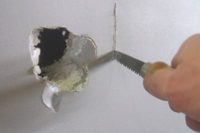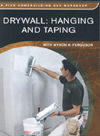Some arrive as a fresh take on an old application situation-“Faster! Lower labor costs!” claim the advertisements for a new product-while others attempt to put a spin on the composition of a traditional material. In either situation, claims about the “bad” characteristics of the traditional material or system abound.
With regard to some of the claims made for a few new materials in the wall and ceiling industry, we would suggest caution. Apples don’t always equal apples in some of the allegations. With respect to claims made about drywall, for example, read on.
WHAT IS DRYWALL?
Statements asserting that materials that do not have a gypsum core are drywall or wallboard are incorrect. Building materials that do not have a gypsum core are not traditional drywall.
Drywall is a synonym for gypsum board. Gypsum board is the technical product name used to define a specific family of gypsum-core board products. In some markets the term plasterboard is also used as a synonym for gypsum board.
The family of gypsum board products includes interior wallboard, water-resistant board, ceiling board, and about a half-dozen other gypsum-core board products. Gypsum board products are typically installed on the walls and ceilings of the interior or exterior of a residential or commercial build-out.
Gypsum board is defined in the ASTM C11 – 08, Standard Terminology Relating to Gypsum and Related Building Materials and Systems, as “the generic name for a family of sheet products consisting of a noncombustible core primarily of gypsum with paper surfacing.” Wallboard is the most common type of gypsum board and has a specific C11 definition that ties it to having a gypsum core.
There are also some products that do not have a paper facing that are commonly called drywall. Technically, these products are known as gypsum panel products and are defined by the C11 standard as “a family of sheet products consisting essentially of gypsum.” Glass faced panels and panels manufactured without a facing that have a gypsum core are examples of gypsum panel products.
So, it’s really quite simple to understand what a sheet of drywall is. The sequential logic works as follows:
- To be considered a gypsum board or a gypsum panel, you must have a core that is predominantly gypsum.
- Drywall is short-hand for gypsum board (or gypsum panel in many instances).
- Drywall is gypsum board. And vice versa.
MANUFACTURING CHARACTERISTICS
Gypsum board (drywall) is manufactured to the ASTM C1396 standard. The applicability of the standard is limited by its scope and the scope of ASTM C1396 states, “this specification covers the gypsum boards described …” The standard goes on to list all of the various gypsum board products that could be manufactured to the standard, including wallboard, soffit board, water-resistant board, and others.
The C1396 standard establishes specific characteristics and tolerances for drywall products. These include general physical properties, such as flexural strength, humidified deflection, and nail-pull resistance, that are applicable to all drywall products, and specific physical properties, such as water resistance and water absorption, that are germane to only a handful of board types.
To a manufacturer, the use of the standard is clear-cut: if you want to advertise your material as being C1396 drywall, you better be sure that it meets all of the general as well as all of the relevant specific characteristics identified in C1396. If it does not, then the product either is substandard drywall that does not comply with the standard or it is not drywall.
Model building codes and other standards use the C1396 standard as a reference document to define gypsum board. If a code official walks onto a project and finds boards labeled with the C1396 designation, he or she can be confident that the product meets the requirements of the code that mandate that gypsum board is to be manufactured to the C1396 standard.
Could someone slap a false label on some board? Certainly one could do that; however, the liability that attends falsely labeling a product pretty much guarantees that it won’t happen. And since the names of most of the domestic board manufacturers are fairly well known, a new product with such a label would raise some questions.
SELECTIVE EVALUATION
Evidence of the use of a standard for selective or partial evaluation of a building material should raise some questions about both the product and the rationale for a selective evaluation. Such occurrences are especially troubling in instances where the product clearly does not comply with the scope of the standard being used as a reference.
If a material appears to be drywall and uses C1396 for a selective, rather than a full evaluation, then that material likely is: a substandard drywall product that can’t pass muster; a product that actually does not have a gypsum core and is attempting to pass itself off as drywall for marketing purposes; or a gypsum-based product that is something other than drywall.
If the core of the material is not identified, or if it is clearly identified as being something other than gypsum, then the C1396 standard should not be used for a full or partial evaluation because the scope of the standard limits its use to gypsum core materials. A sheet of plywood, for example, could very likely pass the nail pull criteria contained in C1396; however, no one is ever going to confuse plywood with drywall. To a sensible person, the two materials are clearly not the same.
If the material does not have a gypsum core, then it should be properly evaluated using a standard with a scope that more appropriately matches the composition of the material in question. If no applicable standard exists, one can be created via ASTM or a similar standards development organization. As an alternative, an acceptance criteria may be obtained from a code evaluation service.
Another occurrence that should raise eyebrows is the use of the type X designation on non-gypsum products. Section 4.3.1 of the ASTM C1396 standard clearly indicates that the type X designation is applicable only to products defined as gypsum board; therefore, use of the designation to define a non-gypsum board product is inappropriate. While meeting the requirements of a fire test and establishing compliance with the definition of a type X material are related exercises, they are fully independent concepts and achievement of a fire test listing does not convey compliance with the type X criteria as defined by ASTM C1396. This is particularly the case when a non-gypsum core material is under consideration.
If imitation is the sincerest form of flattery, then drywall is blushing bright red, for competitive materials that come onto the market often spend a significant amount of time and money passing themselves off as “the best alternative to drywall” or “better than drywall.” Every material that makes it to market and survives has positive attributes; if it didn’t, it would not survive the process of coming to market. However, piggybacking on a good material via selective information presentation does all of us a disservice and tends to create confusion about the real differences between materials. W&C





Report Abusive Comment